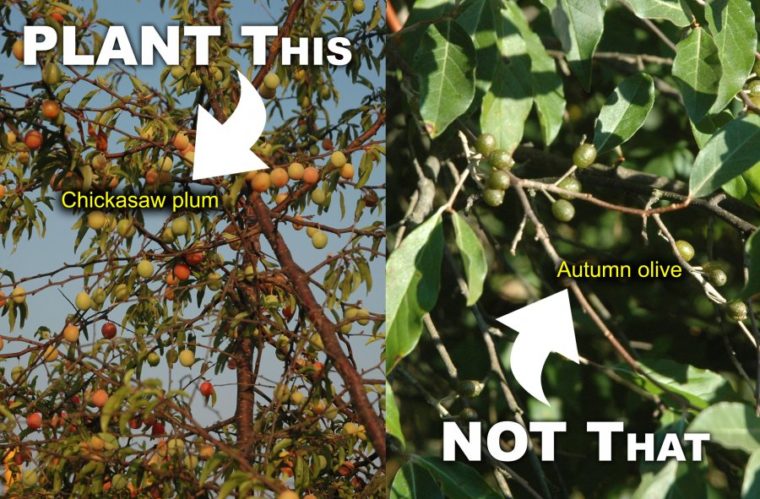Oh man! I could not believe it. In an effort to relax and wind down from a long day, I had just sat down, flipped on the television to my favorite hunting channel and proceeded to watch a self-proclaimed habitat “expert” actually promote planting a non-native, invasive shrub called autumn olive (Elaeagnus umbellata) as a visual screen around his food plot. My blood pressure immediately charged skyward. Mis-informed, mis-guided, whatever the case, this person was spouting poor advice to his viewers, and I immediately felt it was my duty to get the word out to landowners and hunters interested in land and wildlife management about the numerous alternatives to what I like to refer to as “bad choice” plants.
First, a few definitions are in order; it’s important to recognize that plants can be either native or non-native, and they can be either invasive or non-invasive. The holy grail of “bad choice” plants are, for the most part, those that are both non-native (meaning that they are from another continent or at least not indigenous to the area, and are present only by means of direct or indirect human intervention) and invasive (meaning that it has a tendency to spread uncontrollably and is likely to cause economic or environmental damage or harm to human health). To be fair, yes, there is a whole host of plants that fit this description that have become naturalized across North America today and are commonly found growing across the landscape; however, in my humble opinion, that should not give us permission to continue planting or promoting them! Two wrongs never make a right.
So, to help provide some guidance to those interested in providing valuable food, cover and/or shelter to white-tailed deer or other wildlife species on their properties, and who want to do it by planting native and/or non-invasive plants, I will offer some of my favorite alternatives to the Most Wanted list of “bad choice” plants out there. Many of these offer the same exact benefits, but without the cost or negative tendencies.
If you’ve had an experience planting any of these native species, or simply want to share your past invasive species removal efforts with others, I encourage you to post your comments below.
Shrubs
PLANT THIS NOT THAT
| “Bush” honeysuckle (Diervilla lonicera) or Red-osier dogwood (Cornus sericea) or Old field aster (Aster pilosus) |
Tartarian honeysuckle (Lonicera tatarica) |
| Black haw (Viburnum prunifolium) | Privet (Ligustrum spp.) |
| Ninebark (Physocarpus opulifolius) or Prairie willow (Salix humilis) or American plum (Prunus americana) or Chickasaw plum (Prunus angustifolia) or Smooth sumac (Rhus glabra) |
Autumn olive (Elaeagnus umbellata) |
| Climbing prairie rose (Rosa setigera) | Multiflora rose (Rosa mulitiflora) |
| American beautyberry (Callicarpa americana) or Highbush blueberry (Vaccinium corymbosum) |
Winged Euonymus (Euonymus alatus) |
| American winterberry (Ilex verticillata) or Witch alder (Fothergilla gardenia) or New Jersey tea (Ceanothus americanus) or Virginia sweetspire (Itea virginica) |
Japanese barberry (Berberis thunbergii) |
Trees
PLANT THIS NOT THAT
| Serviceberry (Amelanchier laevis) | Bradford pear (Pyrus calleryana) |
| Shingle oak (Quercus imbricaria) or Water oak (Quercus nigra) or Willow oak (Quercus phellos) |
Sawtooth oak (Quercus acutissima) |
| Devil’s walking stick (Aralia spinosa) | Chinaberry (Melia azedarach) |
| Witch hazel (Hamamelis virginiana) or Highbush cranberry (Viburnum opulus var. americanum) or Common elderberry (Sambucus canadensis) |
European buckthorn (Rhamnus cathartica) |
| Pecan (Carya illinoinensis) or Butternut hickory (Carya cordiformis) |
Tree of Heaven (Ailanthus altissima) |
Vines
PLANT THIS NOT THAT
| Scarlet honeysuckle (Lonicera sempervirens) | Japanese honeysuckle (Lonicera japonica) |
| American bittersweet (Celastrus scandens) | Oriental bittersweet (Celastrus orbiculatus) |
| American climbing fern (Lygodium palmatum) | Japanese climbing fern (Lygodium japonicum) |
Grasses
PLANT THIS NOT THAT
| Prairie cordgrass (Spartina pectinata) | Maiden grass (Miscanthus sacchariflorus) |
| Sugarcane plumegrass (Saccharum giganteum) or Lindheimer’s muly grass (Muhlenbergia lindheimeri) |
Pampas grass (Cortaderia selloana) |
| Little bluestem (Schizachyrium scoparium) | Smooth brome (Bromus inermis) |
| Purpletop (Tridens flavus) | Tall fescue (Festuca arundinacea) |
